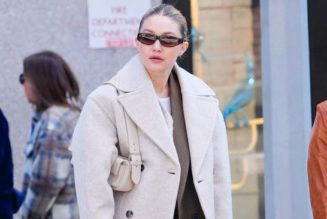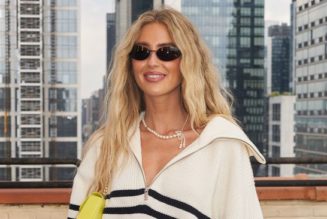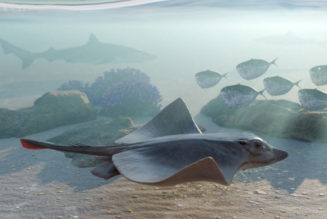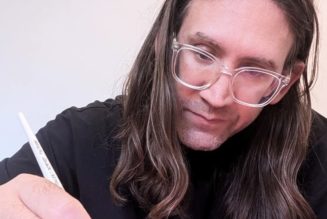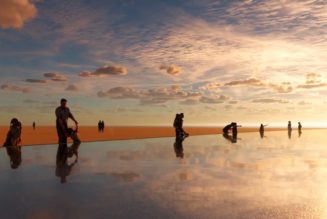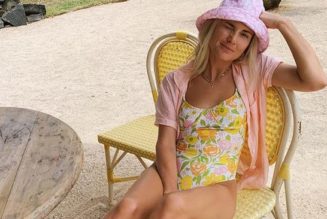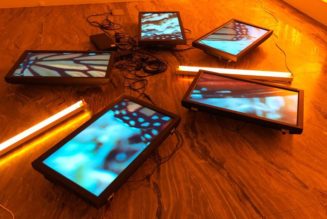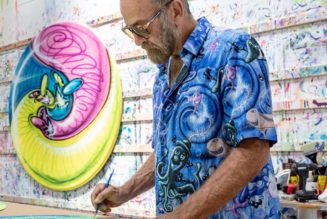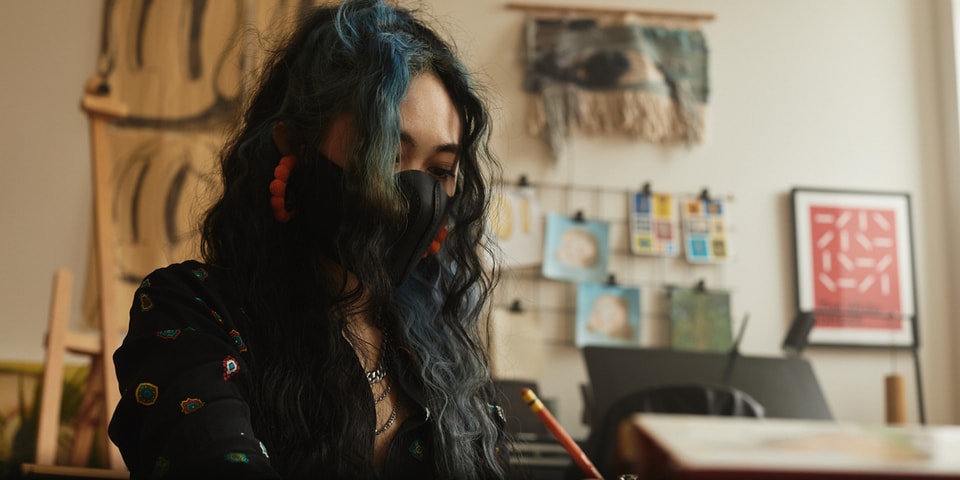
Building an online presence under the name All Seeing Seneca, the artworks of Seneca present opportunities for exploration, like the forms of interactive storytelling in her favorite video games. Her most widely shared pieces include an NFT collection that debuted at Art Basel Miami 2021 and her work as the lead artist behind Bored Ape Yacht Club. Featuring multiple styles of illustration, Seneca’s characters are driven by their eyes and facial expressions, which aren’t obviously happy and sad, or cute and scary. They contain combinations of human-like qualities and pockets of surreal details that can aid viewers when uncovering the stories in her art.
Working as an illustrator for most of her career, Seneca has a strong sense of composition in her digital and physical works. Like a well-designed poster, her pieces depict a single subject in aesthetically-pleasing colors and big, cartoon-style eyes that draw viewers in. She paints rosy-cheeked girls with coy, or blank expressions who are surrounded by floating hands, hidden galaxy patterns, flowers with psychedelic faces and leafy vines that wrap around their heads. While some pieces are digitally native, they resemble her physical paintings through skillfully-shaded elements, dreamy gradients and shadows that add depth to seemingly one-dimensional characters.
Partnering with Coinbase for this installment of Studio Visits, HYPEBEAST spoke to Seneca about her approach to storytelling through illustration, and how people can better understand her work as the worlds of digital and physical art continue to merge.
HYPEBEAST: Tell me about the relationship between your physical paintings or illustrations and your work with NFTs.
For paintings in my OpenSea and SuperRare collections, it was all digitally native. I sketch on Photoshop, then I paint from there. I do paint physically and draw on pen and paper, but I treat those mediums differently and my work turns out very different. I like to separate the two.
Physical artwork can be translated to the commercial world and traditional art market. Digital art has a long history of seen as being lesser because assets can only exist in reproductions. There’s no provenance. There’s no authentication. I don’t treat my artwork differently when I turn them into NFTs. It’s just a matter of becoming more valuable in the eyes of collectors. Monetary value is important, it opens up new doors to how I express myself and creates more opportunities. But, I try not to let that get in the way of my work.
What do you think is the biggest misconception you hear about NFTs?
I want to address the question of whether NFTs themselves are art or not. You hear about this debate about defining NFTs… somebody was trying to claim that NFTs were art and people have to understand that they are two separate things. Once we sell digital art as NFTs, they answer questions of provenance and establish verification. It’s basically a certificate, right? NFTs are the technology behind it. Art and its value exists separately from NFTs. Also, I think the term NFT artist will be obsolete. It’s like calling a painter, a canvas artist. That’s something that I’m adamant about.
Who are some of your favorite artists and who would be a dream collaboration?
Off the top of my head, I’m heavily inspired by David Lynch. I talk about him all the time in my work and I feel like he’s a kindred spirit. If I could look up to him, the way he treats the world and the way he sees the world that would be the pinnacle. I also love like Jack White, the musician. I love Gustav Klimt. Junji Ito, he’s the horror master of manga. I love Maurice Sendak, Mary Blair, people who have a great eye for design. And dream collab, I would’ve loved to collaborate with Max Fleischer, I’m a big fan of retro cartoons.
How would you describe your style and your characters?
Having a singular character or great composition helps draw the eye to places and creates a message clearly. I love surrealism, animation and horror. Some people describe my style like Candy Land mixed with gothic horror, I think it’s kind of cool. I don’t want to state it so bluntly because I think other people’s interpretations are important. And echoing off David Lynch, he also feels frustrated when asked to spell out his work because we express ourselves in these mediums for a reason. To translate things back into words, it kind of misses the point.
Do you have any early internet experiences that may have sparked your interest in online creations?
When I had gotten on the internet, I was so invested in video games. I loved Runescape and BattleOn, that’s when I connected with online community. And it makes sense because I love video games now. They’re the pinnacle of interactive storytelling, so it’s all intertwined. Oh, I also love point and clicks. That’s something that people don’t talk about enough, but I love like mystery point and clicks, like Nancy Drew series. I could go on and on.
Besides gaming online, using programs like Microsoft Paint and KID PIX 3D, the early art programs that were extremely bare bones. Those were the beginnings of me experimenting with digital mediums and I haven’t forgotten it. I think we may even be getting back to that aesthetic. People are really hungry for analog and retro styles.
Are there any current video games that you like to play?
I’ve always been into heavy storytelling. I love psychological horror games. The BioShock franchise is one of my favorites. I love the world-building in that game. I love Undertale, Inscryption, an amazing game that combined two different styles. I feel a bit envious because that’s something I would’ve loved to develop if I made a game.
Why do you think NFTs are taking off as a whole right now? What are the reasons for their mass adoption and popularity?
I think NFTs are taking off because it speaks our language. We’re living in an era of technology, and frankly, a lot of us have invested in our online presence more than ever. Whether you realize it or not, our lives are deeply intertwined with digital operations and the metaverse, so this feels natural and speaks to the younger generation who will grow up in the era of digital ownership. It’s happening whether people like it or not. As a creative working in digital creation, it’s also a totally natural transition. I felt like it was inevitable.
What are some qualities that you look for in NFT projects or organizations when you’re considering a collaboration?
First and foremost, we need to know the integrity behind the project, so I’d like to know what the project stands for or what their prerogative is. Personally, artistic integrity is super important, but sometimes I look past the artwork, the quality of artwork, and I want to see the message and how well they’ll execute. That’s really important before I invest in anything or collaborate with anybody.
Do you have any personal tips for developing projects or ideas with longevity?
It’s a hard call because you can’t determine the market or how things move, trends come and go. My biggest advice would be to stay true to your idea. Whatever your intention is, have conviction in that and stay the course. If you try to cater to a certain trend, you’re setting yourself up to fail because you’d always be one step behind. The moment you finish your project, it’s already passé. All ideas aren’t original, so it’s not so much worrying about originality. It depends on your taste and your execution level, but at that point, it’s also a handoff thing.
What are the benefits of being an anonymous online creator?
I’m partially anonymous because I like fashion, I like to play with silhouettes and apparel but keeping my face hidden has its benefits. It helps people realize my work before they judge my face. I think women have it incredibly hard being objectified online. It also helps separate my work from me as a person, and to a degree, I have to maintain that for my mental health.
As an artist who works heavily with web3, how do you balance your time between being offline and online?
That’s something that I’ve been struggling with for sure. I’ve integrated into my online presence more than ever, but I love to unplug and play guitar. I like to take long walks up and down with city while listening to instrumentals. That’s the only thing that can take my mind off work. It’s nonstop from the moment I plug in, I plug into a different world.
Is there anything that you’re currently working on that you’re excited about?
I’m working on my next collection that I’m planning on releasing in March. And I might auction off my last piece from my debut collection. I wasn’t feeling ready to let go of that piece, but that may drop in February. There’s also some exciting collaborations that I’m trying to work out. I’m super excited for all that.
[EDITOR’S NOTE: Since this interview was conducted, Seneca auctioned off “LITTLE ONE,” the fifth and final piece from her genesis collection on February 27, 2022. It was purchased by 0xStudio founder @radiosolace for 39.69Ξ (about $116,146 USD).]
That’s fascinating that you can feel that same kind of attachment to a digital piece as a physical painting in your studio.
I think we’ve been all brainwashed for so long into thinking digital art is not as good. I’m trying to convince myself of this because it’s mind-boggling that people are looking at my Instagram going like, ‘Wow, this is like a great piece. Like, can I buy it?’ This is bizarre. It’s so surreal and it’s incredibly exciting.
[flexi-common-toolbar] [flexi-form class=”flexi_form_style” title=”Submit to Flexi” name=”my_form” ajax=”true”][flexi-form-tag type=”post_title” class=”fl-input” title=”Title” value=”” required=”true”][flexi-form-tag type=”category” title=”Select category”][flexi-form-tag type=”tag” title=”Insert tag”][flexi-form-tag type=”article” class=”fl-textarea” title=”Description” ][flexi-form-tag type=”file” title=”Select file” required=”true”][flexi-form-tag type=”submit” name=”submit” value=”Submit Now”] [/flexi-form]

